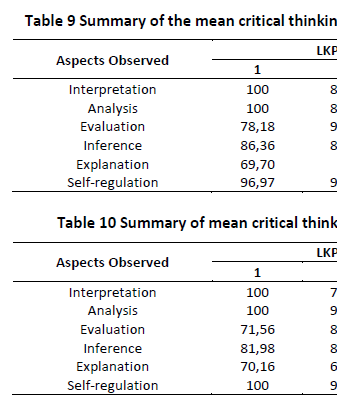Learning outcomes and critical thinking skills of Islamic Senior High School students in the virus chapter using Nearpod media
DOI:
https://doi.org/10.58362/hafecspost.v3i1.50Keywords:
nearpod media quality, learning outcomes, critical thinking skills, virusAbstract
The world of 21st-century education requires a generation that can utilize technology and think critically. Nearpod media, which contains indicators of critical thinking skills, is a solution that is expected to increase student engagement and classroom processes. This study investigates the effect of using Nearpod media on students' learning outcomes and critical thinking skills in understanding the discussion of viruses. The quasi-experiment method was used for product cognitive research, while the descriptive approach was used for process cognitive, affective, psychomotor, and critical thinking skills research. The purposive sampling technique was applied to X A and X E students as treatment and control classes. Product cognitive data analysis was conducted using pretest and posttests, which were tested using SPSS 16. The results showed that the use of Nearpod media had a significant effect on product cognitive learning outcomes. In the virus discussion, the cognitive process of using Nearpod media reached the good category, while the affective and psychomotor aspects reached the good and very good categories. Critical thinking results showed an increase in the analysis, interpretation, and evaluation indicators; then, the inference and self-regulation indicators reached the very good category. Explanation reached the good enough category and improved during learning in the experimental class. This study confirms that using Nearpod media can improve students' learning outcomes and critical thinking skills in understanding the discussion of viruses at Islamic Senior High School.
Abstrak. Dunia pendidikan abad 21 membutuhkan generasi yang mampu memanfaatkan teknologi dan berpikir kritis. media Nearpod yang memuat indikator kemampuan berpikir kritis menjadi solusi yang diharapkan dapat meningkatkan keterlibatan siswa dan proses di kelas. Penelitian ini menginvestigasi pengaruh penggunaan media Nearpod terhadap hasil belajar serta kemampuan berpikir kritis peserta didik dalam memahami pembahasan virus. Metode eksperimen semu digunakan untuk penelitian kognitif produk, sementara pendekatan deskriptif digunakan untuk penelitian kognitif proses, afektif, psikomotorik, dan kemampuan berpikir kritis. Teknik purposive sampling diterapkan pada peserta didik X A dan X E sebagai kelas perlakuan dan kontrol. Analisis data kognitif produk dilakukan dengan pretest dan posttest yang diuji dengan SPSS 16. Hasil menunjukkan bahwa penggunaan media Nearpod berpengaruh signifikan terhadap hasil belajar kognitif produk. Pada pembahasan virus, kognitif proses menggunakan media Nearpod mencapai kategori baik, sementara aspek afektif dan psikomotorik mencapai kategori baik dan sangat baik. Hasil kemampuan berpikir kritis menunjukkan peningkatan pada indikator analisis, interpretasi dan evaluasi, lalu indikator inferensi dan pengaturan diri mencapai kategori sangat baik. Eksplanasi mencapai kategori cukup baik dan mengalami peningkatan selama pembelajaran pada kelas eksperimen. Penelitian ini menegaskan bahwa penggunaan media Nearpod dapat meningkatkan hasil belajar dan kemampuan berpikir kritis peserta didik dalam memahami pembahasan virus di Madrasah Aliyah.

Downloads
Published
Issue
Section
License
Copyright (c) 2024 Lidya Nilam Cahaya, Bunda Halang, Aminuddin Prahatama Putra

This work is licensed under a Creative Commons Attribution-NonCommercial-ShareAlike 4.0 International License.

This work is licensed under a Creative Commons Attribution-NonCommercial-ShareAlike 4.0 International License.























